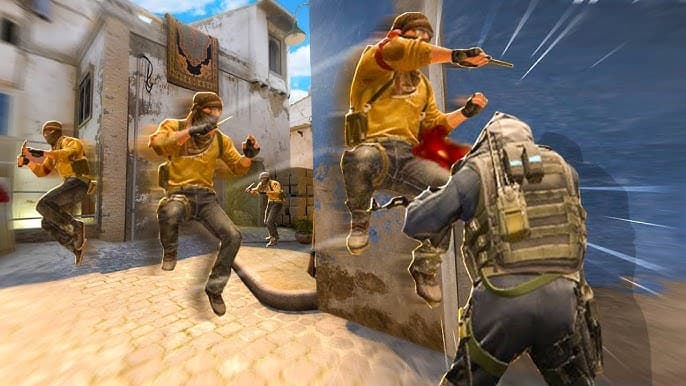
CS2 Movement Update: What Changed and How to Adapt Your Gameplay
The latest CS2 movement update has sent shockwaves through the Counter-Strike 2 community, fundamentally altering how players approach movement mechanics. Released on July 28, 2025, this controversial update has left many players frustrated as their beloved bunnyhopping techniques have been severely disrupted, while simultaneously breathing new life into surfing mechanics.
If you've noticed that your movement feels different, clunky, or downright broken since the recent patch, you're not alone. Thousands of players worldwide are grappling with these changes, searching for answers and adaptation strategies. This comprehensive guide breaks down exactly what changed, why it happened, and most importantly, how you can adapt your gameplay to stay competitive.
Breaking Down the Latest CS2 Movement Changes
The CS2 movement update rolled out on July 28, 2025, delivering subtick-engine changes under the hood, animation overhauls, and movement limitations. Valve's patch notes referenced a fix to a bug in the bhopping penalty system and subtle adjustments to input handling.
Specifically:
sv_jump_spam_penalty_timewas increased, introducing a delay on ground-to-jump input so consecutive hops register poorly- A cap was placed on subtick input commands per tick, limiting simultaneous strafing-mouse motion sequences
These two core changes form the basis of what players now call the CS2 movement update. While Valve intended to address exploitative movement mechanics, the implementation has had far-reaching consequences that extend beyond their original scope.
The update also included animation overhauls with new deploy, reload, and inspect cycles, but it's the movement mechanics that have captured the community's attention and frustration.
The Bunnyhopping Controversy: What Broke and Why
Several community posts flagged that CS2 bunnyhopping broken has become reality. Users claim that after the update, chaining more than a single bhop is near impossible:
"you cant even do more than 1 hop … something stops you … the movement is messed up"
"you simply cannot jump after you hit the ground, theres an increased delay"
These match Valve's fix to bhopping bug described in the official notes, which intended to reset jump spam penalty timing immediately, but in practice delays normal jump timing drastically.
Before the patch, pro users could string fast scroll-wheel jumps and strafes to maintain speed. Post-patch, many report that even space-bar bhops lose effectiveness. The limit on inputs per tick (subtick cap) further disrupts complex strafe patterns. Some believe Valve overcompensated, breaking bhop chaining as a side-effect.
Technical Breakdown of the Changes
The CS2 bunnyhopping broken issue stems from two main technical modifications:
- Increased Jump Spam Penalty: The
sv_jump_spam_penalty_timevariable now enforces a longer delay between consecutive jumps - Subtick Input Limitations: A new cap on simultaneous input commands per tick prevents the rapid input sequences that made consistent bunnyhopping possible
These changes effectively eliminate the ability to chain multiple hops together, fundamentally altering movement patterns that players have relied on for years.
Surfing Gets a Revival: How the Fix Changes Everything
Players also noted that CS2 surfing fixed surfaced alongside this patch. While Valve didn't explicitly call it out, community testers observed that triangle-hitbox surface friction and landing velocity behavior were tweaked—users report smoother speed retention when landing surf lines.
Despite the disruption of bunnyhopping mechanics, code changes appear to correct some surf glitch physics. That's why maps like surf_utopia and surf_skilz now feel more consistent. Unlike bhop disruption, surfers reach higher speeds from ramp-to-ramp transitions. It seems Valve's code update aimed to fix staggery surfaces, inadvertently breaking bhop spam logic.
Impact on Surf Maps
The CS2 surfing fixed update has brought several improvements:
- Better speed retention between surf ramps
- More consistent physics on triangle hitboxes
- Smoother transitions that feel more predictable
- Reduced friction issues that previously caused unexpected slowdowns
This has reinvigorated the surfing community, with many players reporting that classic surf maps now feel more enjoyable and skill-expressive than before.
The FPS Limitation Discovery: Infinite Bunny Potential
Another hot topic: players experimenting with the CS2 FPS limit infinite bunny scenario. Some testing shows capping FPS to a low value (e.g. sv_maxfps 32) reduces subtick overflow and lets limited bhops chain more reliably. Using sync-bound frame cap may bypass the per-tick input cap by spacing commands across ticks.
Several communities reported that at low frame rates, you're able to land and jump again before the penalty timer resets. Before this patch, movement keyed off tick-based ground detection. Now, that detection plus spam cap combine to throttle bhop. Locking FPS artificially helps players exploit timing windows.
Before vs After Comparison
Before the patch:
- You could reliably bind mousewheel and chain dozens of hops
- Smooth acceleration through bhop chains was possible
- Movement felt fluid and skill-expressive
After the patch:
- Even spacebar fails to pick up after landing until a delay passes
- Scroll wheel jumping suffers the same limitations
- Movement feels restricted and inconsistent
Impact on Competitive Play and Map Control
These movement changes reshape competitive play and map control significantly. The CS2 movement update has forced players to reconsider fundamental strategies that relied on quick rotations and momentum-based plays.
Map-Specific Changes
Dust2 Impact:
- CT-catwalk rotations via bhop have slowed drastically
- CT players can no longer accelerate into cat from short or mid effectively
- Long rotations require more time, affecting round timing
Mirage Consequences:
- Vault-jump and window exits using bhop/strafing combos now fail in high-stakes matches
- Slower rotations at upper B
- Lost momentum for quick mid-to-connector transitions
Positive Changes: However, improved surfing fixes breathe life into surf-jump tactics sometimes used in niche sites (e.g. Overpass B heaven). Some pros suggest surf-based bait plays may return stronger.
How to Adapt Your Movement Training
Adapting to the CS2 movement update requires a complete overhaul of your movement training routine. Here's a comprehensive adaptation strategy:
1. Retrain Jump Timing
Focus on one-hop movement—expect a ground-jump delay. Train precise timing to avoid double-tap spam. Practice single, well-timed jumps rather than attempting to chain multiple hops.
2. Adjust Your FPS Cap
Capping your FPS (e.g. to 60 or even 32) can reduce subtick overload. This may help with consistency when chaining limited hops. Experiment with different FPS limits to find what works best for your playstyle.
3. Emphasize Surf and Ramp-Based Speed
Since CS2 surfing fixed now retains speed better, incorporate surf-based entry and rotate drills on maps like Nuke or Overpass. Focus on utilizing environmental geometry for movement advantages.
4. Hone Strafing Mechanics
Your air movement should minimize unnecessary simultaneous mouse-strafe inputs; subtick caps punish combined inputs. Practice clean, separated input sequences.
5. Practice Map-Specific Scenarios
- Dust2 catwalk: Time your jump off drop-down, strafe angle, then land with delay
- Mirage A window to vault: Simulate slower chained hops using timed single-hops
- Cache boost spots: Adapt to new timing requirements for team boosts
Community Reaction and Professional Player Responses
Community reaction on Reddit has been overwhelmingly frustrated:
"Valve have tried to fix surfing, they broke bhopping"
"It is probably easier to add new modules than test regressions"
Players have expressed their disappointment with the changes:
"they removed the ability to bunnyhop, try it ingame … they in fact completely broke it, could string pretty consistent hops and now u literally can't do shit lol"
Pro players have reportedly shifted to beta branch "bhopping" in Valve's own test builds, indicating Valve is experimenting with rollback or tuning. There's no official Valve statement promising full bhop restoration, but the presence of test branches confirms they're responsive to feedback.
Professional Scene Adaptation
The professional Counter-Strike scene is actively adapting to these changes:
- Teams are revising their rotation strategies
- Players are practicing new movement patterns in scrimmages
- Tactical timeouts are being used differently due to slower rotations
- Some teams are exploring surf-based plays that were previously impractical
FAQ: CS2 Movement Update Questions
Q1: Is bunnyhopping permanently broken in CS2?
A: In the live build (as of July 28, 2025), multi-hop chaining is largely non-functional due to increased spam penalty timing and subtick caps. However, Valve appears to be testing adjustments in beta branches.
Q2: Can I bypass the problem with config binds or scripts?
A: No. Valve disabled movement-enhancing aliases and macros, and scroll-wheel jump now suffers the same delay as space-bar. The limitations are built into the game engine.
Q3: Does lowering FPS help with bunnyhopping?
A: Yes—players report that locking FPS to a lower rate like 60 or even 32 allows limited bhopping when timing perfectly. This exploits timing windows in the subtick system.
Q4: Has surfing actually improved?
A: Yes—community reports indicate surf tracks retain speed better post-patch on surf maps like surf_utopia and surf_skilz, making surfing more exploitable and enjoyable.
Q5: What should pro players change in their training?
A: Focus on surf lines, single-hop timing drills, map-specific rotate techniques, and efficient strafing without overloading input per tick.
Q6: Will Valve revert these changes?
A: While there's no official statement, Valve's testing of "bhopping" in beta branches suggests they're aware of community feedback and may make adjustments.
Q7: How do these changes affect different skill levels?
A: Higher-skilled players who relied heavily on movement mechanics are most affected, while newer players may not notice significant differences in their gameplay.
Q8: Are there any movement techniques that still work well?
A: Yes—counter-strafing, basic air strafing, and surf-based movements have actually improved or remained effective.
Conclusion
The CS2 movement update represents one of the most significant mechanical changes to Counter-Strike in recent memory. While the disruption to bunnyhopping has frustrated many players, the improvements to surfing mechanics and the discovery of FPS-based workarounds show that the community is already adapting.
Understanding these changes is crucial for maintaining competitive performance. Whether you're a casual player looking to improve your movement or a professional seeking every advantage, adapting to the new CS2 movement mechanics 2024 will determine your success in the evolving meta.
At RepaCheater, our community is already discussing how these movement changes affect player performance and teammate compatibility. You can now check player profiles to see how they've adapted to the new mechanics—are they still trying to force old bhop techniques, or have they successfully transitioned to the updated movement system?
Use RepaCheater to find teammates who understand the new meta. Check their recent match stats, read community feedback about their adaptability, and see reputation scores from other players who've experienced their gameplay firsthand. With the CS2 movement update changing everything, having reliable teammates who've mastered the new mechanics is more important than ever.
Join RepaCheater today to build your reputation as a player who adapts quickly to meta changes, connect with skilled teammates who understand the new movement system, and leave feedback about how other players handle these mechanical shifts. Because in the post-update CS2 landscape, your teammate's ability to adapt matters just as much as their aim.
